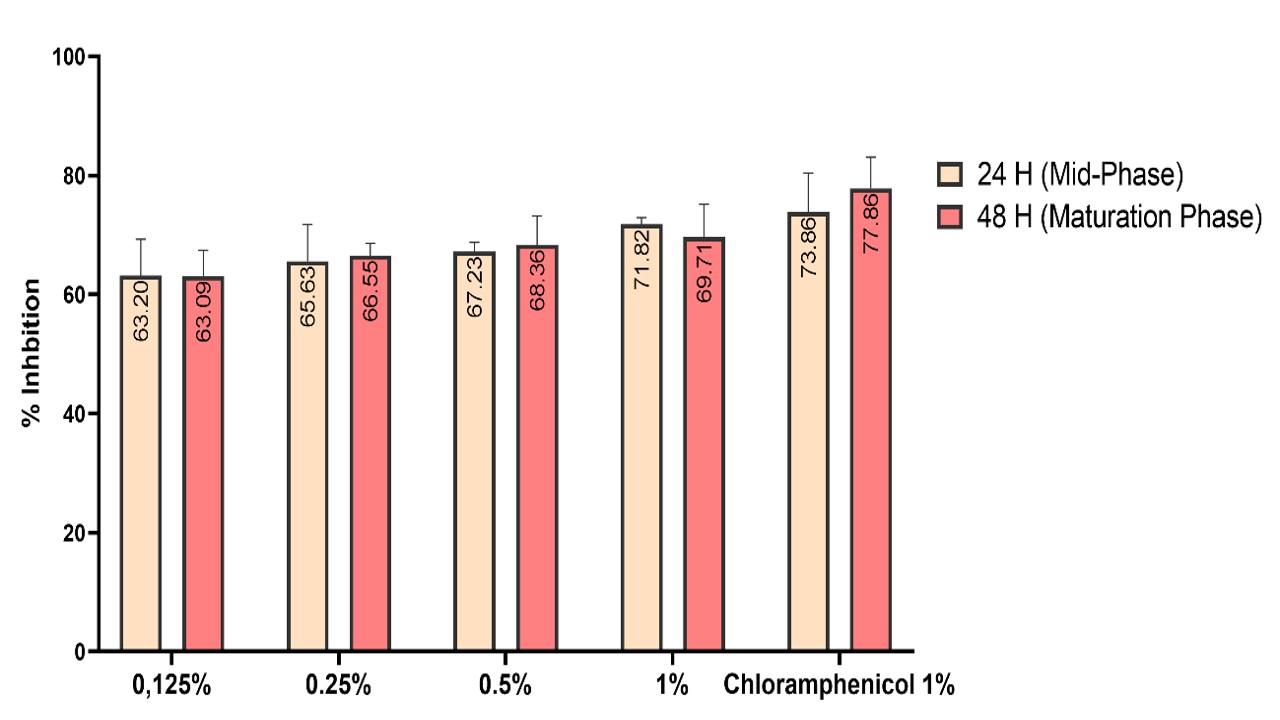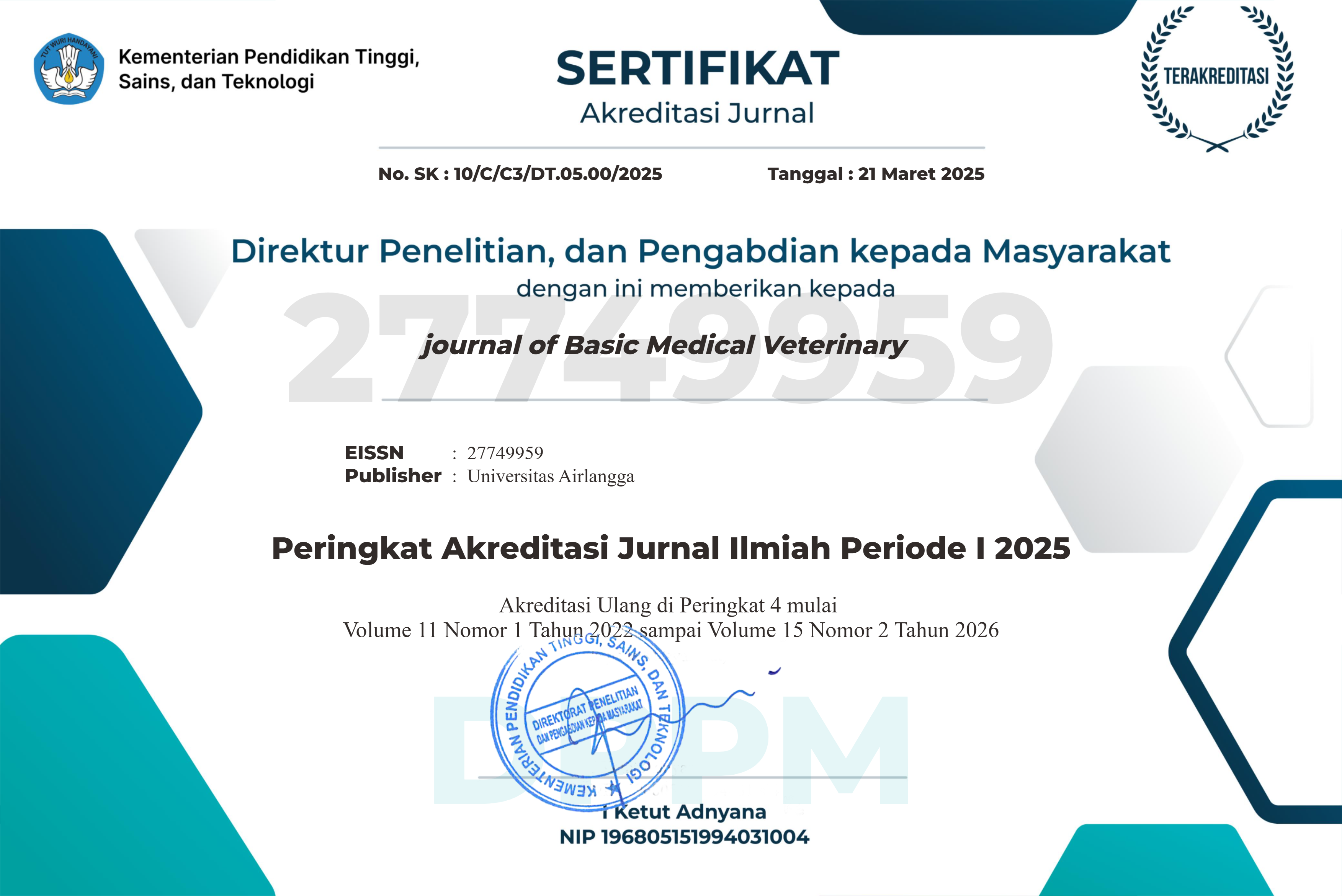Marine Sponge Petrosia sp. from Maratua Island: A Potential Source of Antibiofilm Agents Against Pathogenic Biofilms

Downloads
Microbial biofilm-associated infections, particularly those caused by Pseudomonas aeruginosa and Candida albicans, have emerged as global challenges due to resistance to conventional antimicrobials. This study investigated the antibiofilm activity of ethanol extract from the sponge Petrosia sp., collected from the waters of Maratua Island, against both pathogens. Extraction was performed using 96% ethanol maceration, followed by in vitro biofilm inhibition and eradication assays using the broth microdilution method in microtiter plates. Biofilm density was quantified through crystal violet staining and absorbance measurement (OD₅₉₅ nm). The results demonstrated that the extract inhibited both intermediate-stage (24 hours) and mature-stage (48 hours) biofilm formation, with an MBIC₅₀ of 0.125% for both microorganisms. At a concentration of 1%, the inhibition percentages reached 73.86% for P. aeruginosa and 84.70% for C. albicans. The highest mature biofilm eradication activity was observed at 1% concentration, with MBEC₅₀ values of 51.98% for P. aeruginosa and 80.53% for C. albicans, approaching the effectiveness of positive controls (nystatin 82.04% and chloramphenicol 61.72%). The extract exhibited a dose-dependent pattern, with greater efficacy against C. albicans, possibly due to differences in biofilm matrix composition. These findings confirm the potential of Petrosia sp. as a source of multitarget antibiofilm compounds, particularly for fungal infections, and underscore the significance of Indonesia’s marine biodiversity as a basis for innovative therapeutic development.
Chen, X., Thomsen, T.R., Winkler, H., Xu, Y. 2020. Influence of biofilm growth age, media, antibiotic concentration and exposure time on Staphylococcus aureus and Pseudomonas aeruginosa biofilm removal in vitro. BMC Microbiology 20, 264.
Cooper, C.J., Krishnamoorthy, G., Wolloscheck, D., Walker, J.K., Rybenkov, V.V., Parks, J.M., Zgurskaya, H.I. 2018. Molecular Properties That Define the Activities of Antibiotics in Escherichia coli and Pseudomonas aeruginosa. ACS Infect. Dis. 4, 1223–1234.
Di Domenico, E.G., Oliva, A., Guembe, M. 2022. The Current Knowledge on the Pathogenesis of Tissue and Medical Device-Related Biofilm Infections. Microorganisms 10, 1259.
Duplantier, M., Lohou, E., Sonnet, P. 2021. Quorum Sensing Inhibitors to Quench P. aeruginosa Pathogenicity. Pharmaceuticals 14, 1262.
Fahdianto, A.N., Astriani, N.A., Pratama, V.Y., Hamzah, H., Yudhawan, I. 2024. Penelusuran Aktivitas Antibiofilm Dan Formulasi Spons Petrosia Sp. Sebagai Nanogel Penyembuh Luka Ulkus Diabetikum Akibat Infeksi Biofilm Staphylococcus aureus. JIIS 9, 292–302.
Gheorghita, A.A., Wozniak, D.J., Parsek, M.R., Howell, P.L. 2023. Pseudomonas aeruginosa biofilm exopolysaccharides: assembly, function, and degradation. FEMS Microbiology Reviews 47, fuad060.
Hamzah, H., Hertiani, T., Pratiwi, S.U.T., Nuryastuti, T. 2019. The Inhibition Activity of Tannin on the Formation of Mono-Species and Polymicrobial Biofilm Escherichia coli, Staphylococcus aureus, Pseudomonas aeruginosa, and Candida albicans. Majalah Obat Tradisional 24, 110–118.
Koo, S.H. 2015. Overexpression of Efflux Pump in Multiresistant Pseudomonas aeruginosa : How You Will Discover and Treat It? Infect Chemother 47, 142.
Krislee, A., Fadly, C., Nugrahaningsih, D.A.A., Nuryastuti, T., Nitbani, F.O., Jumina, Sholikhah, E.N. 2019. The 1-monolaurin inhibit growth and eradicate the biofilm formed by clinical isolates of Staphylococcus epidermidis. BMC Proceedings 13, 19.
Kumar, D., Kumar, A. 2024. Molecular Determinants Involved in Candida albicans Biofilm Formation and Regulation. Mol Biotechnol 66, 1640–1659.
Lee, K., Yoon, S.S. 2017. Pseudomonas aeruginosa Biofilm, a Programmed Bacterial Life for Fitness. Journal of Microbiology and Biotechnology 27, 1053–1064.
Lee, Y.-J., Cho, Y., Tran, H.N.K. 2021. Secondary Metabolites from the Marine Sponges of the Genus Petrosia: A Literature Review of 43 Years of Research. Mar. Drugs 19, 122.
Malaka, M.H., Hartina, H., Fristiohady, A., Sadarun, B., Sahidin, I. 2021. Isolation And Identification Of Secondary Metabolite From Ethyl Acetate Extract Of Petrosia Sp. And Its Antioxidant Activity. JFSP 7, 365–373.
Malinovská, Z., Čonková, E., Váczi, P. 2023. Biofilm Formation in Medically Important Candida Species. Journal of Fungi 9, 955.
Mochtar, C.F., Sholikhah, E.N., Nugrahaningsih, D.A.A., Nuryastuti, T., Nitbani, F.O. 2020. Inhibitory and eradication activities of 1-monolaurin as anti-biofilm on monospecies and polymicrobial of Staphylococcus epidermidis and Candida tropicalis. Int. J. Pharm. Res. 13, 550–560.
Ong, K.S., Mawang, C.I., Daniel-Jambun, D., Lim, Y.Y., Lee, S.M. 2018. Current anti-biofilm strategies and potential of antioxidants in biofilm control. Expert Review of Anti-infective Therapy 16, 855–864.
Pascayantri, A., Ningsih, M.B., Sadarun, B., Malaka, M.H., Fristiohady, A., Malik, F., Sahidin, I. 2021. In Vitro Cytotoxicity Assay Of Petrosia Sp. Ethanol Extract By Using Mtt Method Of T47d Breast Cancer Cell Line. JFSP 7, 405–411.
Pierce, C., Vila, T., Romo, J., Montelongo-Jauregui, D., Wall, G., Ramasubramanian, A., Lopez-Ribot, J. 2017. The Candida albicans Biofilm Matrix: Composition, Structure and Function. JoF 3, 14.
Pratiwi, S.U.T., Hamzah, H. 2020. Inhibition and Degradation Activity of (Sapindus rarak seeds) ethanol extract against polymicrobial biofilm. RJPT 13, 5425–5430.
Sandai, D., Tabana, Y.M., Ouweini, A.E., Ayodeji, I.O. 2016. Resistance of Candida albicans Biofilms to Drugs and the Host Immune System. Jundishapur J Microbiol 9.
Setyowati, E., Irzani, E.F., Luthfi, C.F.M., Hamzah, H. 2024. Tracing The Antibacterial, Antifungal And Anti-Biofilm Activities Of Root Extract Bajakah Tampala (Spatholobus Littoralis Hassk). JFSP 10, 32–41.
Ta, C., Arnason, J. 2015. Mini Review of Phytochemicals and Plant Taxa with Activity as Microbial Biofilm and Quorum Sensing Inhibitors. Molecules 21, 29.
Tuon, F.F., Dantas, L.R., Suss, P.H., Tasca Ribeiro, V.S. 2022. Pathogenesis of the Pseudomonas aeruginosa Biofilm: A Review. Pathogens 11, 300.
Usman, Y., Ramadan H., T., Aliyu, I.A., Sharif, A.A., Umar, K., Abdullahi, I.N. 2023. Significance of Pseudomonas aeruginosa efflux pump system in antibiotic resistance. SJMLS 8, 87–95.
Zhang, K., Li, X., Yu, C., Wang, Y. 2020. Promising Therapeutic Strategies Against Microbial Biofilm Challenges. Front. Cell. Infect. Microbiol. 10.
Copyright (c) 2025 Chaerul Fadly Mochtar, Hasyrul Hamzah, Muhammad Tursina Bakti, Abdul Rozak

This work is licensed under a Creative Commons Attribution-ShareAlike 4.0 International License.
Journal of Basic Medical Veterinary (JBMV) by Unair is licensed under a Creative Commons Attribution-ShareAlike 4.0 International License.
1. The journal allows the author to hold the copyright of the article without restrictions.
2. The journal allows the author(s) to retain publishing rights without restrictions
3. The legal formal aspect of journal publication accessibility refers to Creative Commons Attribution Share-Alike (CC BY-SA).
4. The Creative Commons Attribution Share-Alike (CC BY-SA) license allows re-distribution and re-use of a licensed work on the conditions that the creator is appropriately credited and that any derivative work is made available under "the same, similar or a compatible license”. Other than the conditions mentioned above, the editorial board is not responsible for copyright violation.







 Perhimpunan Dokter Hewan Indonesia
Perhimpunan Dokter Hewan Indonesia








